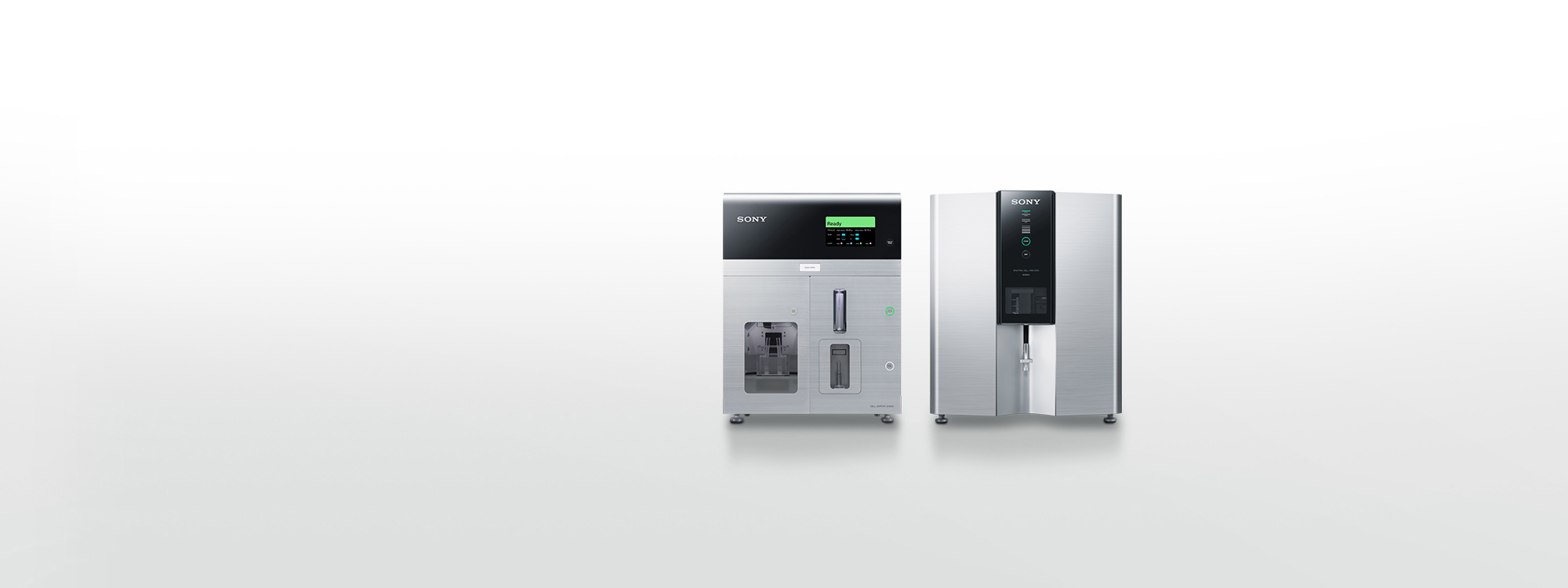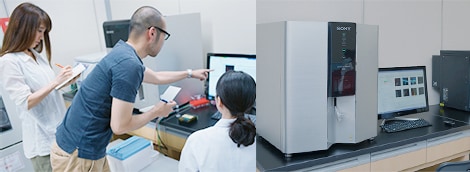SH800 /
SP6800

Advancing
into medical frontiers
Using flow cytometry systems,
researchers worldwide study
stem cells and treatment of cancer,
autoimmune diseases, and other conditions.
Sony has entered into new territory
by designing and developing
this medical research equipment.
Design Concept
〈 SH800 / SP6800 〉
How Sony can contribute
in medicine
Flow cytometry systems are specialized equipment used in cell analysis and research. For Sony, entering into the their development and design was truly exploring new territory. Gaining insight for design all began with on-site observation and interviews, so that design would stem from in-depth observation of the functionality researchers need.
We observed some issues with current systems, which were large enough to dominate labs and complex enough (structurally and operationally) to inconvenience researchers. Researchers often had to rely on dedicated operators to obtain data, and this hampered research in various ways. We hoped that by applying Sony technology and expertise, we could resolve these issues and make the systems more accessible to researchers themselves. Ultimately, we knew that this would support future progress in medicine.


Design themes that keep us
on the same page
Inevitably, there are compelling reasons for the colors and materials of medical equipment. Superficial design—coordinated logos or equipment styling, for example—cannot support medical advances. What matters most is usability for researchers. In initial design discussions, we approached relevant topics from various angles. We explored potentially fitting design for advanced medical labs based on observations from expert perspectives, and based on ergonomics for greater comfort. To ensure that engineering, product planning, and designers were on the same page, we established shared product design themes.
- Life, Vitality
- Taking on new frontiers
in medicine with a clear, strong will
- Origin, Essence
- Seeking quality
and the power of simplicity
- Inner Cosmos,
Fascinating Inner Worlds - Appreciating the elegance of utility,
intuitive operation, and technology made visible
Industrial Design
〈 SH800 / SP6800 〉

Shapes born in a lab
Spectral Cell Analyzer SP6800 is used in cell analysis, and Cell Sorter SH800 is used from analysis to sorting. In designing both units, our first task was to simplify the complexity that seems inherent in such specialized equipment. In fact, our goal stood in stark contrast to this complexity: simplicity, in forms that follow function. Seeking a compact, tabletop form factor that would also fit in small labs, we succeeded in making the sorter 1/3 the size of conventional units. Both units are constructed of 3-mm thick aluminum to withstand strong disinfectants in labs studying bacteria and viruses. To prevent bacteria from building up, the aluminum panels fit together much like joinery, and uneven surfaces such as screws were avoided as much as possible. Composed of flat, seamless surfaces and rounded, user-friendly edges, the units look uncomplicated—straightforward and powerful.

Usability backed
by thorough testing
This simplicity extends to how the units are used. Through 3D simulations, usability was carefully verified to ensure the units are easy and intuitive to operate. The spectral analyzer features a practical front panel that is centered, easy-to see, and positioned at a convenient angle, for easy sample insertion or removal from either side. On both units, it’s easy to focus on information of interest—whether on an LCD display or indicators—because information is presented against black panels to make the equipment status immediately recognizable. Operation has been simplified through automation and by minimizing the number of buttons. Ongoing discussions with researchers from the stage of prototyping enhanced the practicality of equipment design.

Sample holder
(machined aluminum)

Sorting chip
Better safety in every detail
The sample holder on the spectral analyzer will be used by researchers countless times, so each is machined from a bar of aluminum for strength. The edge of the 3 mm aluminum plate is diamond-cut—a fabrication method also used in audio products—which also imparts a measure of safety in use. A glossy finish around this area makes it easier to wipe, which helps maintain lab cleanliness in consideration of sample agitation during analysis. Safety and accuracy were also priorities in details such as internal optical filter arrangement and flow channel design of sorting chips, which were developed in collaboration with Sony engineers.
designing medical
and research equipment
When designing familiar products, we can rely on ourselves for insight. But when designing specialized equipment used in medicine and research, we can’t design without knowing about how and where products are used. This tests how well designers can understand relevant information from on-site observation: what seems to need improvement, and how we can improve it. Despite the constant pressure of trying to translate insight from the field into better products, it’s very satisfying work.
Iseki, designer

Note: For research use only. Not for use in diagnostic or therapeutic procedures.

noticing simple yet
underlying needs of customers
Lab observation revealed that researchers may be medical specialists, but certainly not experts at operating medical equipment. After observing researchers spending much time and effort operating flow cytometry systems, we knew that design must reduce this workload and help researchers focus on research. In this respect, we were convinced that Sony core competencies developed through consumer electronics would benefit the field of medicine. We also hope to support future medical advances, as a trusted partner in research.
Kimura, producer and designer